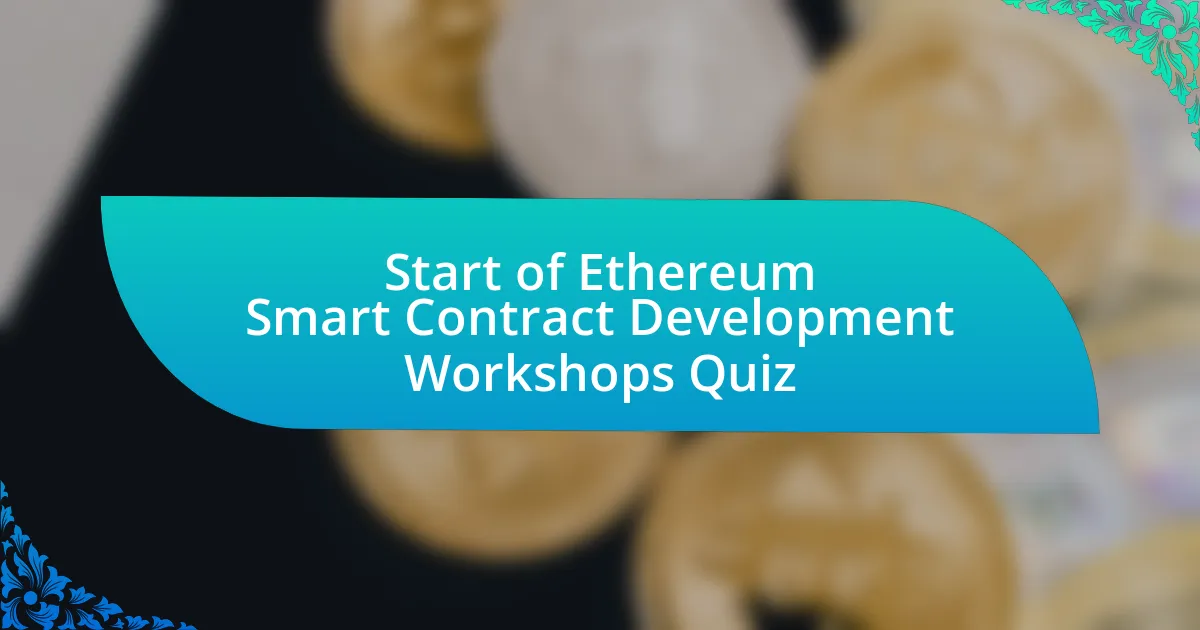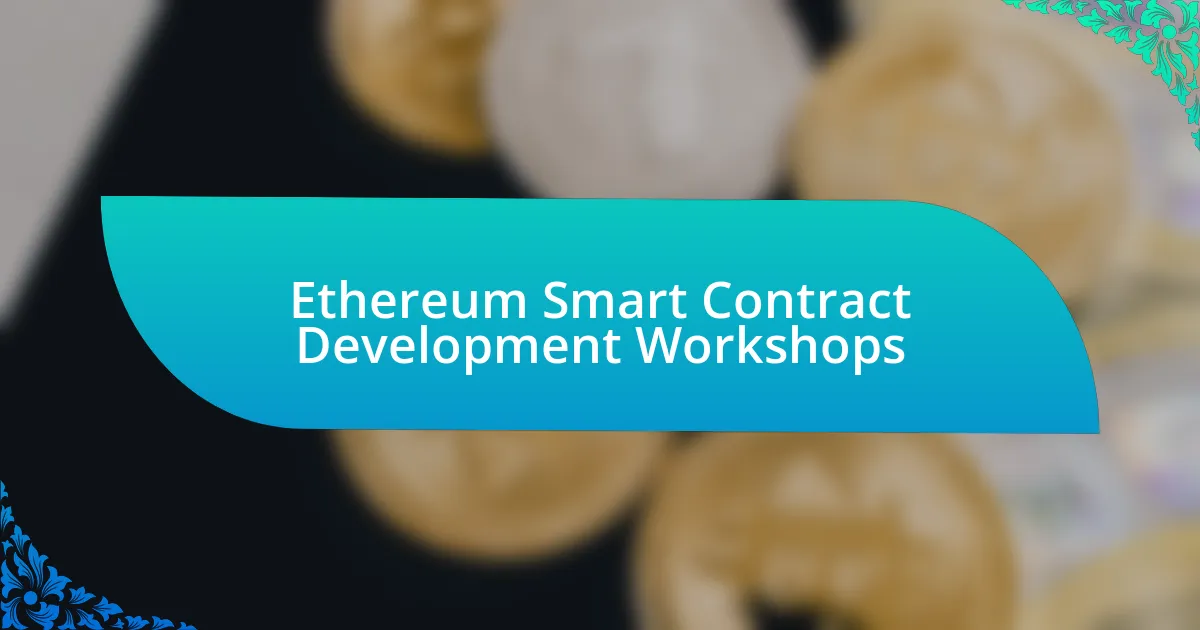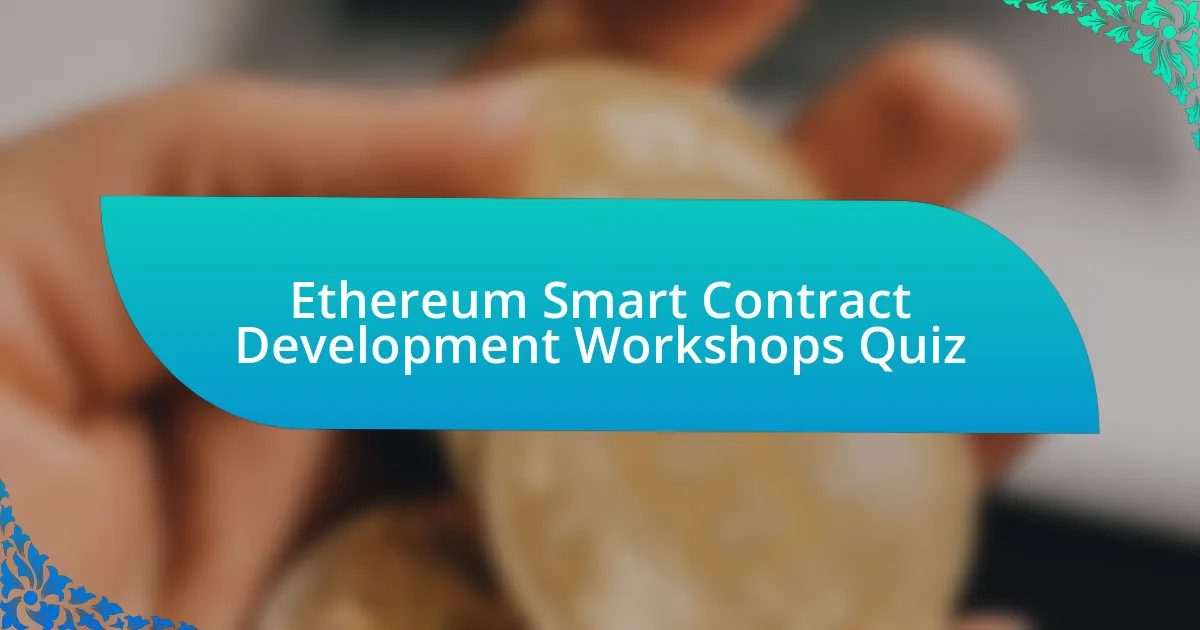
Start of Ethereum Smart Contract Development Workshops Quiz
1. What is the primary language used for writing smart contracts on the Ethereum blockchain?
- Solidity
- Python
- C++
- JavaScript
2. Which framework is commonly used for creating smart contracts?
- Django framework
- React framework
- Angular framework
- Truffle framework
3. What is the purpose of the Ethereum Virtual Machine (EVM) in smart contract development?
- The EVM compiles smart contracts into bytecode for execution on the blockchain.
- The EVM enables smart contracts to communicate with each other directly.
- The EVM acts as a storage system for all smart contracts on Ethereum.
- The EVM provides a graphical interface for editing smart contracts.
4. What are the common data types in Solidity?
- Binary, Date, Complex
- Deque, Char, Float
- Map, Long, Decimal
- UINT, Strings, Address
5. How does Solidity enable deleting elements from arrays?
- Removing index
- Updating function
- Incrementing values
- Copying elements
6. What is the role of the Remix IDE in smart contract development?
- The Remix IDE is an integrated developer environment used for developing smart contracts written in Solidity.
- The Remix IDE is a graphics editor for creating blockchain visuals.
- The Remix IDE is a wallet for storing cryptocurrencies securely.
- The Remix IDE is a messaging platform for communicating with developers.
7. What are the key features of Ethereum smart contracts that increase their reliability?
- Centralized authority, encryption, and user access controls.
- Immutability, transparency, and decentralized consensus mechanisms.
- High transaction fees, long processing times, and off-network execution.
- Limited access, third-party verification, and temporary storage.
8. What makes smart contracts deployed on the Ethereum blockchain immune to unauthorized changes?
- Regular software updates allow the code to be modified safely without issues.
- Smart contracts are protected by encryption techniques that secure the code.
- The immutability of the blockchain ensures that once deployed, the code cannot be altered.
- Centralized servers host the contracts to safeguard them from hacking attempts.
9. How does the transparency of Ethereum smart contracts help establish trust among participants?
- Transparency ensures that all participants are unknown to each other.
- Transparency means contracts can be edited after deployment.
- Transparency allows participants to see the code and execution of smart contracts, fostering trust.
- Transparency allows for faster transactions and reduced fees.
10. What characteristic of Ethereum smart contracts prevents their code from being altered once deployed?
- The complexity of the deployment.
- The immutability of the blockchain.
- The flexibility of the code.
- The initial coding errors.
11. What aspect of the Ethereum blockchain ensures that the execution of smart contracts is not reliant on a single authority or server?
- Decentralized consensus mechanisms.
- Centralized servers.
- Managed execution platforms.
- Authority-controlled nodes.
12. What is the purpose of the MetaMask client for Ethereum?
- The MetaMask client connects to an Ethereum network and facilitates interactions with smart contracts.
- The MetaMask client serves as a mining software for Ethereum.
- The MetaMask client is designed solely for trading cryptocurrencies.
- The MetaMask client generates tokens for Ethereum users.
13. Which tools in the Truffle Suite speed up smart contract development?
- Hardhat and Etherscan tools.
- Ganache and Drizzle tools.
- Solidity compiler and Remix IDE.
- Vyper and Web3.js tools.
14. What are the roles of solc-js and the Remix IDE in developing smart contracts?
- solc-js is a web browser, and Remix IDE is a photo editing tool.
- solc-js is a compiler for Solidity, and Remix IDE is an integrated developer environment for developing smart contracts.
- solc-js is a testing framework for decentralized applications, and Remix IDE is a social media platform.
- solc-js is a wallet for storing Ether, and Remix IDE is a game development platform.
15. What are the characteristics of full, light, and archive nodes in Ethereum?
- Full nodes require no synchronization, light nodes generate blocks, and archive nodes replicate data.
- Full nodes store the entire blockchain, light nodes store only necessary data, and archive nodes store historical data.
- Full nodes connect only to miners, light nodes save all block headers, and archive nodes maintain current state.
- Full nodes only verify transactions, light nodes act as intermediaries, and archive nodes are obsolete.
16. How does unit testing help in checking the functionalities of smart contracts?
- Unit testing eliminates the need for transaction validation on the blockchain.
- Unit testing checks whether a smart contract works as intended by testing individual components.
- Unit testing ensures smart contracts are always immutable after deployment.
- Unit testing automatically audits smart contracts for security vulnerabilities.
17. What is the recommended approach for testing the functionalities of different components in smart contracts?
- Performance testing.
- Manual testing.
- Code reviewing.
- Unit testing.
18. What is the role of the Truffle framework in smart contract development?
- The Truffle framework exclusively manages Ethereum node synchronization.
- The Truffle framework acts as a wallet for storing cryptocurrencies.
- The Truffle framework audits smart contracts for security vulnerabilities.
- The Truffle framework provides tools and features to speed up smart contract development.
19. What is the purpose of the application binary interface (ABI) in interacting with smart contracts?
- The ABI executes the smart contracts on the network.
- The ABI provides a way to interact with smart contracts by defining the interface between the contract and external applications.
- The ABI creates the user interface for interacting with smart contracts.
- The ABI generates random addresses for smart contract deployment.
20. How does the Ethereum Virtual Machine (EVM) interact with smart contract bytecode?
- The EVM compiles bytecode into readable code.
- The EVM stores smart contract bytecode permanently.
- The EVM executes smart contract bytecode on the blockchain.
- The EVM manages user interfaces for smart contracts.
21. What are the key components of the smart contract development lifecycle?
- Designing, deploying, testing, and securing.
- Writing, compiling, debugging, and launching.
- Planning, implementing, auditing, and retiring.
- Creation, deployment, testing, and maintenance.
22. What is the significance of learning smart contract development for decentralized applications (dApps)?
- Smart contracts are essential for decentralization in dApps.
- Smart contracts are only useful for centralized applications.
- Smart contracts slow down the performance of dApps.
- Smart contracts increase reliance on centralized servers.
23. How does the installation and configuration of Hardhat IDE facilitate smart contract development projects?
- Hardhat IDE simplifies the user interface for web browsing.
- Hardhat IDE increases cryptocurrency mining efficiency.
- Hardhat IDE enables social media integration for developers.
- Hardhat IDE provides a development environment for executing smart contract development projects.
24. What are the recommended tools for smart contract unit testing?
- Simulation software like AutoCAD.
- Development environments like Visual Studio.
- Testing frameworks such as Truffle Test.
- Database management tools like MySQL.
25. What is the significance of implementing the ERC20 token standard in smart contract development?
- The ERC20 token standard ensures instant transaction confirmations for all contracts.
- The ERC20 token standard provides a standard for creating and managing tokens on the Ethereum blockchain.
- The ERC20 token standard allows unlimited data storage on the blockchain.
- The ERC20 token standard is used for creating non-fungible tokens only.
26. How does the deployment workflow of smart contracts involve test networks and web3 providers?
- Test networks and web3 providers are used to deploy and test smart contracts before deployment on the mainnet.
- Web3 providers are only needed after smart contracts are deployed on the mainnet.
- Test networks are only used for storing user data and do not interact with web3 providers.
- Smart contracts are deployed directly on the mainnet without any testing phase.
27. What are the essential best practices for coding, testing, and deploying smart contracts?
- Best practices include using proprietary languages, avoiding rigorous testing, and neglecting community standards.
- Best practices include using testing frameworks, following the ERC20 token standard, and ensuring immutability.
- Best practices include relying on one developer, ignoring regression testing, and using outdated libraries.
- Best practices include avoiding documentation, using random frameworks, and skipping code reviews.
28. What is the role of the MetaMask client in connecting to an Ethereum network?
- The MetaMask client is used for storing Ethereum network nodes.
- The MetaMask client facilitates connections to the Ethereum network and interactions with smart contracts.
- The MetaMask client serves as a gaming platform for Ethereum-based games.
- The MetaMask client creates smart contracts on the Ethereum network.
29. How does the transparency of Ethereum smart contracts contribute to establishing trust among participants?
- Transparency hides the code, making it difficult for users to trust each other.
- Transparency increases complexity, resulting in less trust among participants.
- Transparency allows participants to see the code and execution of smart contracts, fostering trust.
- Transparency only applies to financial transactions, not smart contracts.
30. What makes smart contracts deployed on the Ethereum blockchain invulnerable to hacking or unauthorized changes?
- Centralized control makes it easy to change contract details when needed.
- Smart contracts can be easily modified by developers even after deployment.
- Regular updates to the code allow for flexibility without restrictions.
- The immutability of the blockchain ensures that once deployed, the code cannot be altered.

Congratulations! You’ve Successfully Completed the Quiz
Well done on completing the quiz about Ethereum Smart Contract Development Workshops! We hope you enjoyed the process and found it both informative and engaging. This quiz has covered fundamental topics such as smart contract functionality, essential programming languages, and best practices in development. Each question was designed to enhance your understanding of how Ethereum works in practical applications.
Throughout this quiz, you likely learned not only about the technical aspects of smart contracts but also about their real-world implications. Understanding how to create, deploy, and manage these contracts can significantly boost your skills in blockchain development. You may have also discovered the importance of testing and security measures in ensuring the reliability of your contracts.
Now that you have completed the quiz, we invite you to explore the next section on this page. Here, you will find more detailed information about Ethereum Smart Contract Development Workshops. These workshops can further expand your knowledge and help you put into practice what you’ve learned. Dive deeper into the world of smart contracts and continue your learning journey with us!

Ethereum Smart Contract Development Workshops
Introduction to Ethereum Smart Contract Development Workshops
Ethereum Smart Contract Development Workshops are structured programs designed to teach participants how to create and manage smart contracts on the Ethereum blockchain. These workshops encompass hands-on training, theoretical knowledge, and practical projects. Participants learn the basics of blockchain technology, Ethereum’s architecture, and the Solidity programming language. Such workshops are typically aimed at developers, entrepreneurs, and enthusiasts who wish to delve into blockchain applications and decentralized finance.
Key Components of Smart Contract Development Workshops
The key components of Ethereum Smart Contract Development Workshops include coding sessions, case studies, and group discussions. Coding sessions focus on writing and deploying smart contracts using Solidity. Case studies involve analyzing successful projects that utilized smart contracts. Group discussions foster collaborative learning and help participants share insights and challenges. These components ensure a comprehensive understanding of smart contract lifecycle management.
Target Audience for Smart Contract Workshops
The target audience for Ethereum Smart Contract Development Workshops includes software developers, blockchain enthusiasts, and professionals from various industries. Developers with prior programming experience can quickly grasp advanced concepts. Entrepreneurs interested in blockchain solutions can learn how to leverage smart contracts for their ventures. Additionally, students seeking to enter the blockchain space benefit from structured learning opportunities.
Benefits of Attending Ethereum Smart Contract Workshops
Attending Ethereum Smart Contract Development Workshops offers numerous benefits, including enhanced skills, networking opportunities, and real-world project experience. Participants gain hands-on experience in writing smart contracts. Workshops provide a platform to connect with industry experts and like-minded individuals. Engaging in real projects boosts confidence and practical knowledge, making participants more competitive in the job market.
Potential Applications of Skills Gained from Workshops
The skills acquired from Ethereum Smart Contract Development Workshops can be applied in various sectors. Participants can develop decentralized applications (dApps), create tokens, or engage in initial coin offerings (ICOs). The understanding of smart contracts also extends to implementing solutions in supply chain management, finance, and digital identity verification. As blockchain technology evolves, these skills remain in high demand across various industries.
What are Ethereum Smart Contract Development Workshops?
Ethereum Smart Contract Development Workshops are educational sessions focused on teaching participants how to create and deploy smart contracts on the Ethereum blockchain. They typically cover programming languages like Solidity, tools like Truffle or Hardhat, and techniques for interacting with the Ethereum network. The effectiveness of these workshops is supported by the growing demand for blockchain skills, as indicated by the number of developers transitioning to Ethereum development in recent years.
How do participants benefit from Ethereum Smart Contract Development Workshops?
Participants benefit by gaining practical skills in smart contract development, which enhances their career opportunities in the blockchain industry. Workshops often provide hands-on experience, fostering deeper understanding of concepts and tools used in Ethereum development. According to a report by LinkedIn, blockchain skills are among the top in-demand skills for tech jobs in 2023, highlighting the value of such training.
Where can one find Ethereum Smart Contract Development Workshops?
Ethereum Smart Contract Development Workshops can be found online and at various technology education centers worldwide, including coding boot camps, universities, and blockchain conferences. Numerous organizations, such as ConsenSys Academy and Blockchain at Berkeley, offer specialized workshops, often advertised through their websites and social media channels.
When are Ethereum Smart Contract Development Workshops typically held?
Ethereum Smart Contract Development Workshops are held throughout the year, varying based on the organizer’s schedule. Many organizations align their workshops with significant events in the blockchain community, such as conferences or hackathons. Online platforms often provide workshops on demand, allowing participants to learn at their convenience.
Who usually facilitates Ethereum Smart Contract Development Workshops?
Ethereum Smart Contract Development Workshops are typically facilitated by experienced developers, educators, or industry professionals with expertise in blockchain technology. Many facilitators have backgrounds in computer science or software development, and some hold certifications in Ethereum-specific tools. Their expertise ensures that attendees receive relevant and practical knowledge applicable to real-world projects.

